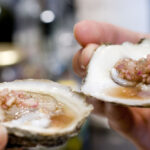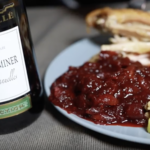
I’ve spent most of my life in Yorkshire, a sprawling county in the north of England which is full of, assuming you buy into the stereotype, flat-cap-wearing, whippet-owning, ale-guzzling farmers. Blustery moorland, myriad converted mills and smoke-blackened buildings dominate the Yorkshire landscape, standing testament to the rural-yet-industrial heritage of the region. It’s also bloody cold most of the year.
So, of all the things Yorkshire does well — cricket (mostly), pork pies (definitely) — I never thought wine would, or could, be one of them. But my home county is nothing if not full of surprises.
Over the course of two weekends, I set out to visit three Yorkshire vineyards, working my way from Holmfirth and Leeds in my home of West Yorkshire— the sole English entry on National Geographic’s 2019 Cool List—before migrating north to Nun Monkton, North Yorkshire.
Holmfirth Vineyard
Just twenty minutes from my childhood home, Holmfirth Vineyard — which has since semi-rebranded as Sheveling Wine Estates, thanks to the recent purchase of wine-growing land out near Whitby on the East coast — was my first stop.

As I rounded the final hairpin, heart-in-your-mouth-steep corner up to Holmfirth Vineyard, I had already begun to understand why it was worth the visit. The view — all tiny hamlets and rolling hills as far as the eye can see — is, in a word, magnificent. Enough to move even the most desensitised-to-their-surroundings local to snap a picture or twenty.
Established in 2008, Holmfirth Vineyard could easily be written-off as the expensive experiment of a wealthy couple — Ian and Becky retired in their thirties after illustrious careers, before relocating to Holmfirth — but the excellent wines and facilities of their winery prove otherwise.
The seven-acre plot of vines, once home to a flock of sheep but now the site of five different grape varietals, contrasts sharply with the state-of-the-art building which anchors Holmfirth Vineyard. Dry-stone walls divide the land, separating Rondo grapes, which produce the winery’s light-bodied red, from the Solaris which goes into the bulk of the whites. All the grapes at Holmfirth Vineyard are similarly hardy hybrids, bred specially to withstand the often brutal cold of Yorkshire winters (and summers, for that matter).
Their dry rosé was a stand-out for me, fizzing on the tongue at first sip before mellowing out. In fact, many an opinion was changed that day, with their red turning the head of a white wine drinker. She was, in a handful of words, pleasantly surprised. I couldn’t have agreed more.
Tours run 365 days a year and cost 10 GBP per person. Sheveling Estate wines are sold exclusively on site at the time of writing.
Leventhorpe Vineyard
Established in 1985, Leventhorpe Vineyard in Leeds wasn’t entirely what I expected when I kicked off my second weekend of exploration. In fact, I first thought I’d somehow, and after a series of wrong turns, mistakenly pulled up to somebody’s house. I mean, I had. The vineyard was next door, operated out of what can only be described as an oversized shed, helmed by George Bowden.

Appearances can be deceiving though, as the rough-and-ready looking Leventhorpe actually produces a number of stellar and quite literally award-winning wines and is the oldest commercial vineyard in Yorkshire. (A similar superlative title — the most northerly commercial vineyard in the country — goes to Ryedale Vineyards in North Yorkshire, which unfortunately wasn’t on my tour schedule.)
I sampled the white wines first, which were delightfully delicate, with a subtlety and nuance of flavor I could only pretend to fully understand at the time. “Apple notes, you say?” Sure. “Peach? Absolutely!”
Turns out, the wines needed to be warmer than the temperatures of a Yorkshire garage in January could offer, so it wasn’t until I got the wine home and could taste it on the comfort of a sofa that I really appreciated its subtleties. Only then did the peach in Leventhorpe’s Madeleine Angevine white make itself really apparent, a flavor welcomed by my fruity-favoring palate.
While I’m certain the proprietor of Leventhorpe Vineyard would have happily shared anecdotes, his encyclopaedic knowledge of wine-making and chatted proper wine procedure well into the afternoon, I had to flit off, hightailing it out of there with my rose gold sparkling wine and apricot-y white in hand. A pre-booked appointment at Yorkshire Heart Vineyard and Winery, in the amusingly-named town of Nun Monkton, awaited.
Tours aren’t offered at Leventhorpe (nor are bathrooms!) but visits—and purchases—are encouraged.
Yorkshire Heart
Plonked between Harrogate and York, Yorkshire Heart Vineyard is owned and operated by Chris and Gillian Spakouskas, who run the entire show with the help of a small staff. Like the couple behind Holmfirth Vineyard, the pair pivoted from a career overseeing milk rounds to open what is perhaps the most expansive vineyard of the three I’ve visited.

At the heart of, well, Yorkshire Heart has always been Gillian’s fondness for fermentation, a minor-obsession which — 13 years later — is now being played out on a pretty grand scale. In fact, over 14 acres of vines, a vast warehouse and a charming café-cum-store make up the site. Something of a step-up from their back garden, although the combination of both passion and proper procedure is apparent in their excellent sparkling wines.
I won’t spoil the fun of Chris’ storytelling, tour-guide talents though, but let’s just say I can see why they won gold for their tourism chops at the International Wine Challenge 2018 Cellar Door of the Year awards. And for beer fans, there’s also a brewery which you can tour if you have a spare hour and a fiver.
Chris also gave the most comprehensive answer to the question I’ll go out on a limb and assume every Yorkshire wine-maker has been asked at one point or another: “Why on earth did you decide to start a vineyard in Yorkshire?” The short answer is simply, surprisingly that Yorkshire has a fantastic wine-growing climate. Just the right amount of sunshine, ideal levels of rain and — as was the case at Yorkshire Heart — a sand and clay foundation which helps the vines stay hydrated through unusually warm summers and nourished in winter.
Who knew?
Even if you’re slightly more cold-averse than the robust grapes across these three vineyards then, it’s worth braving the chilly air up north for a taste of Yorkshire’s first-rate wines.
Tour dates are listed on their website and cost 20 GBP per person, which includes tasting and small cheese and meat platter.

Lauren Cocking is a travel, food and drink writer, specializing in Mexico and Latin America. Follow her inane inner monologue on Twitter at @laurencocking or read her blog Northern Lauren.



